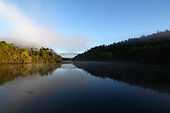Pieman River
Coordinates: 41°37′45″S 144°58′35″E / 41.62917°S 144.97639°E

The Pieman River is a river on the West Coast of Tasmania, Australia. It was dammed with the 122m high Reece Dam in 1986 - creating Lake Pieman.
Name
The once-common suggestion that it was named after a convict "The Pieman" Alexander Pearce who was responsible for one of the few recorded instances of cannibalism in Australia, is not correct. "The Pieman" was in fact Thomas Kent of Southampton, a pastry-cook who was transported to Van Diemen's Land in 1816. After a long series of offences in the colony, he was sent to the Macquarie Harbour Penal Station in 1822 but subsequently escaped, and was recaptured near the mouth of the river which now bears his nickname.[1] The river has significant timber, mining and industrial heritage along its shores.
Hydro scheme
In 1964, well-known photographers Olegas Truchanas and Peter Dombrovskis, together with John Hawkins and Howard Dean, canoed and photographed the Pieman.[2] The damming of the river was the subject of a struggle between conservation groups and Hydro Tasmania, similar to Lake Pedder . The struggle went relatively unnoticed on mainland Australia - and it was the proposed Franklin Dam issue that was to catch a much wider Australian audience than the damming of the Pieman or King Rivers.
The Pieman River Power Development was approved by the Tasmanian government in 1971, construction began in 1974 and it was completed in 1987.[3]
The development included three power stations and five dams:-
- Lake Murchison and Murchison Dam
- Lake Mackintosh, Tullabardine Dam and Mackintosh Dam (Mackintosh Power Station)[4]
- Lake Rosebery and Bastyan Dam (Bastyan Power Station) [5]
- Lake Pieman and Reece Dam (Reece Power Station) [6]
It also included the two major tributaries of the Pieman, the Mackintosh and the Murchison rivers.
It remains Hydro Tasmania's most successfully multi-dammed catchment on the West Coast, and it was developed after the Upper Gordon Scheme (Lake Pedder) and was being completed in the era of the Franklin River controversy. It could be seen as the last major Power Development Scheme undertaken by the Hydro during its stage as an expanding dam-making enterprise. The King River and Henty River developments that followed required specifically challenging engineering on the part of Hydro, but were smaller projects in duration.
Railways
The construction of the scheme also altered the route of the Emu Bay Railway, and submerged a variety of rail heritage sites in the vicinity of the river, notably parts of the Wee Georgie Wood Railway or North Farrell Tramway line.
Notes
- ↑ Sprod, Alexander Pearce of Macquarie Harbour (1977), pp106-18
- ↑ "Shooting the Franklin River". web.archive.org. Archived from the original on 2006-02-21. Retrieved 2007-02-02.
- ↑ Scanlon, Andrew; Tasmania. Hydro-Electric Commission (1990), Water power, HEC, ISBN 978-0-7246-1683-1 page 24
- ↑ Commissioned 1982
- ↑ Commissioned 1983
- ↑ Commissioned 1986/1987
References
- Atkinson, H.K. (1991). Railway Tickets of Tasmania. ISBN 0-9598718-7-X.
- Rae, Lou (1997). The Emu Bay Railway. ISBN 0-9592098-6-7.
- Along the Line in Tasmania. Book 2. Private Lines. Traction Publications. 1972. ISBN 0-85829-003-0.
- Sprod, Dan (1977). Alexander Pearce of Macquarie Harbour. Cat & Fiddle Press. ISBN 0-85853-031-7.
Maps
- Tasmania. Hydro-Electric Commission. Survey Section.(1982) Pieman River power development map [cartographic material] / H.E.C. Map reproduction Survey Section. Ed. 1, 1982. Scale 1:60 000 (E 145°05'--E 145°46'/S 41°37'--S 42°00') Tourist map on orthophoto base, showing power developments, for the area Corinna-Lake Mackintosh-Trial Harbour. Includes power stations, tourist facilities, and historical notes.